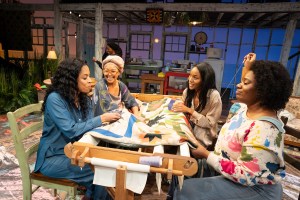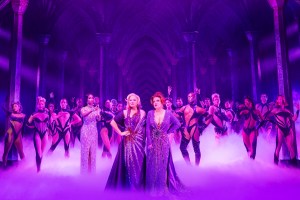(© Joan Marcus)
In May 2013, an analysis of U.S. Census Bureau data revealed that women provide either the sole or primary source of income in 40% of all households with children under the age of 18. This percentage has approximately doubled since Gretchen Cryer and Nancy Ford first presented their powerful feminist musical I’m Getting My Act Together and Taking It on the Road in 1978 at the Public Theater.
Now back in New York for five performances as part of City Center‘s Off-Center Series, the fiercely independent pop/rock-singing protagonist Heather Jones may not seem quite as revolutionary today as she certainly did to the women fresh from the National Women’s Conference and the Equal Rights Amendment rallies nearly four decades ago. Nevertheless, the message of female empowerment is far from antiquated and can resonate with any generation when presented as simply and as poignantly as it is at Encores!
Reneé Elise Goldsberry leads the cast as Heather Jones, following in the footsteps of book writer/lyricist Cryer who originated the role in 1978, as well as Tony Award winner Betty Buckley, who later replaced Cryer when the show transferred from the Public to the Circle in The Square. The musical unfolds in real time as Heather holds a run-through of the new show she has developed before the opening performance that evening (coincidentally, also the day of her 39th birthday). In a surge of inspiration following an unhappy marriage, several sour relationships, and a lifetime of putting on a Stepford smile for the men in her life, she, along with her two powerhouse back-up singers (Christina Sajous and Jennifer Sanchez) unveil a set list that screams “I am woman, hear me roar.”
Rather than her typical roster of stand-by-my-man love songs, Heather presents a score of female power ballads, intimate autobiographical numbers, and a slew of skits worthy of a Wendy Wasserstein play. Goldsberry’s clear and powerful voice more than meets the demands of the role, perfectly capturing the character’s signature strength. She also exhibits an admirable vocal stamina, as there is rarely a number throughout he 90-minute show in which she does not perform.
While academically delving into the topics of gender, sexuality, and marital relationships, she simultaneously pokes fun at the traditional cooking, cleaning, and boxer-laundering housewife — marital clichés that were outdated even in 1978. You can’t help but cheer for Heather’s newfound sense of empowerment and self-discovery during “Strong Woman Number,” one of the night’s biggest crowd pleasers. While this may not be the first (or even the hundredth) time we’ve heard the points this show addresses, they never fail to spur heated post-show discussions and are sure to wake every woman’s dormant inner-feminist beast.
On the opposite side of the picket line is Heather’s manager and ex-lover Joe (played by a hilariously morose yet charming Frederick Weller) who cringes at every unmarketable facet of her new image. Heather responds to his criticism by using him as a receptacle for all of her pent-up relationship frustrations, making for some fantastically satisfying interactions between the two of them. Unfortunately, Goldsberry begins to lose us during these extended book scenes as her character drifts into the realm of a stereotypical feminist shrew, rather than maintaining her sympathetic image as an unappreciated diamond in the rough. However, she instantly wins back our affections with “Old Friend,” one of Ford’s most heartbreaking numbers, which Heather sings to Joe as a tribute to the many years they have weathered and will continue to weather together. Goldsberry delivers the song with a subdued wistfulness that turns the crowd into one giant puddle before the end of the first chorus.
Thankfully, the dialogue has not been modernized for a post-millennium audience. The language stays in the ’70s where it belongs, along with the visual aesthetic, accented by Goldsberry’s high-waist-flare pants (which costume designer Clint Ramos has convinced me should come back into fashion) and the psychedelically patterned fabrics surrounding the stage (designed by Derek McLane). By grounding us in this time period, even those who find the premise to be outdated and personally irrelevant, can, at the very least, look back on this slice of history and celebrate how far we’ve come.










